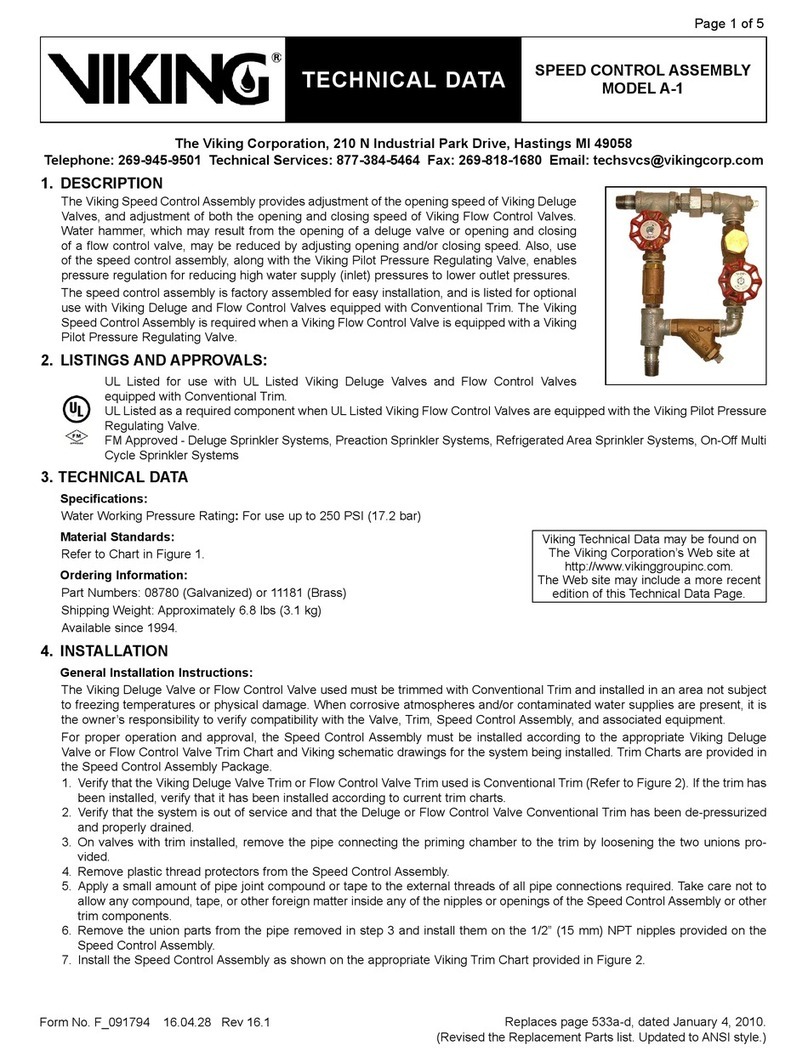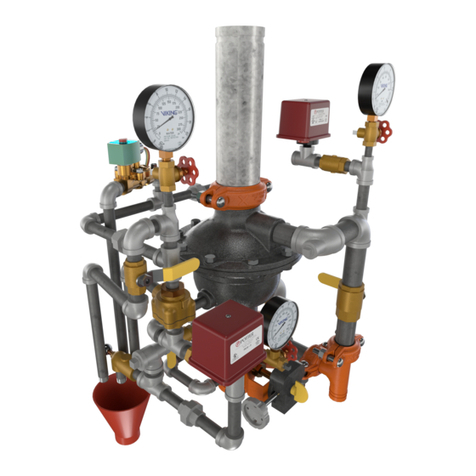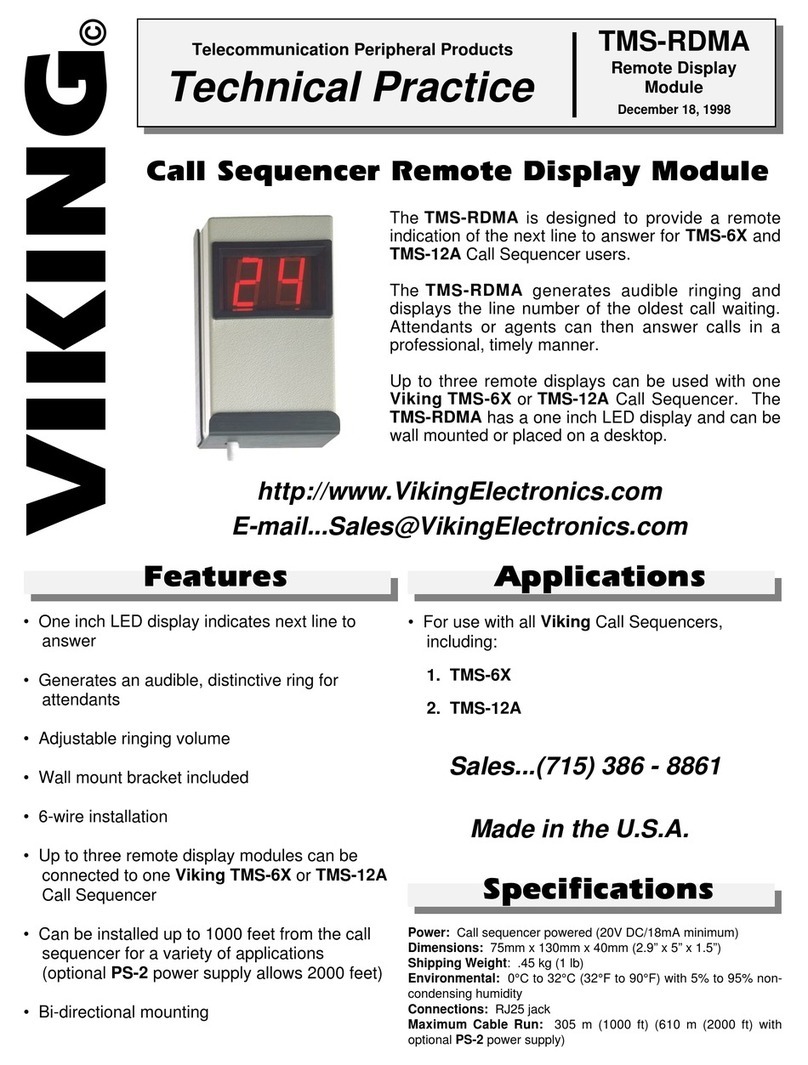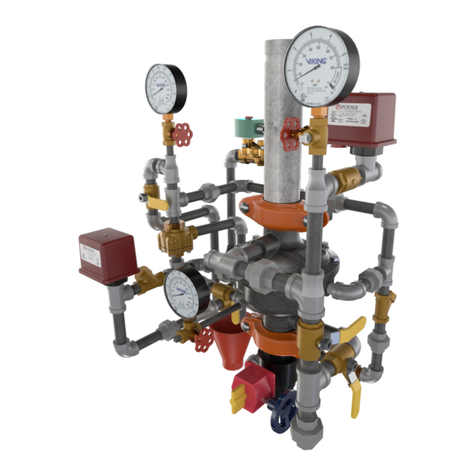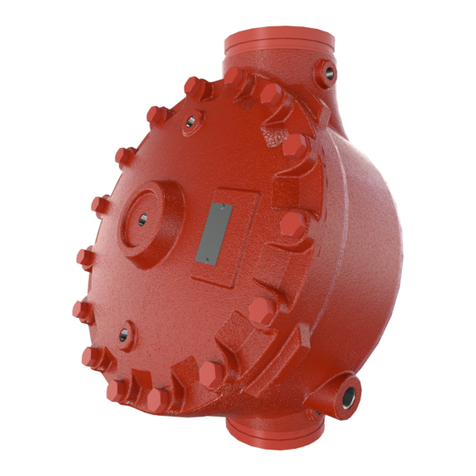
TECHNICAL DATA
4” MODEL G-4000P
DOUBLE INTERLOCK PREACTION
WITH ELECTRIC/PNEUMATIC RELEASE
The Viking Corporation, 210 N Industrial Park Drive, Hastings MI 49058
T
elephone:
269-945-9501
T
echnical
Services:
877-384-5464
Fax:
269-818-1680
Email:
[email protected]Page 3 of 12
Form No. F_112008 18.10.25 P65
Table 1 - Pipe Capacity for Sizing Air Compressors
Pipe Diameter Capacity
US International
Schedule 40 (1” to 6”)
Schedule 30 (8”) Schedule 10
Gal / Ft L / m Gal / Ft L / m
1” DN25 0.045 0.559 0.049 0.608
1-1/4” DN32 0.078 0.969 0.085 1.043
1-1/2” DN40 0.106 1.316 0.115 1.428
2” DN50 0.174 2.161 0.190 2.360
2-1/2” DN65 0.248 3.080 0.283 3.515
3” DN80 0.383 4.756 0.434 5.390
3-1/2” DN90 0.513 6.370 0.577 7.165
4” DN100 0.660 8.196 0.740 9.190
5” DN125 1.040 12.915 1.144 14.206
6” DN150 1.501 18.640 1.649 20.477
8” DN200 2.660 33.032 2.776 30.472
For Metric Units 1 Ft. = 0.3048 M, 1 Gal. = 3.785L
valve body.
3. The G-4000P Valve must be installed in an area not subject
to freezing temperatures or physical damage. If required,
provide a valve house (enclosure) with adequate heat around
the G-4000P Valve and trim. Freezing temperatures will dam- age the G-4000P Valve. When corrosive atmospheres and/or
contaminated water supplies are present, it is the owner’s responsibility to verify compatibility with the Model G-4000P Valve
and associated equipment.
4. The Viking E-1 Accelerator should be installed at the location indicated in Figure 1 when required.
B. Air Supply Design
1. Air Compressor Size
Viking recommends tank mounted air compressors for Double Interlock Electric/Pneumatic Release Preaction Systems. The pneu-
matic actuator requires at least 30 psi (2.1 bar) of air pressure be established within the piping network for systems with water pressure
up to 175 psi (12.1 bar) and 50 psi (3.45 bar) of air pressure for systems with water pressures up to 250 psi (17.2 bar).
NFPA 13 requires the air supply to be capable of lling the entire sprinkler system to its required air pressure within 30 minutes. A
common method of sizing an air compressor is to use the following formula:
Where:
V= Volume
P = Required Air Pressure
T = Fill time (typically 30 min.)
7.48 = gal. / ft.3
14.7 = atmospheric pressure
Compressor
Size (cfm) =
V x P
7.48 x 14.7 x T
Therefore, the compressor shall be capable of providing 7 cfm.
2. Nitrogen Cylinder Gas Supply (See Figure 1)
Nitrogen may be used in place of air compressors. Nitrogen is supplied in pressurized cylinders in various sizes and pressures. Some
of the most common are 122 Cu. Ft. at 1,900 PSI (3,455 Ltrs. at 131 bar), 225 Cu. Ft. at 2,100 PSI (6,372 Ltrs. at 145 bar), and 280
Cu. Ft. at 2,300 PSI (7,930 Ltrs. at 159 bar).
When nitrogen cylinders are used as a primary air supply, spare cylinders should be furnished and located at the valve location.
To determine the approximate amount of nitrogen to be furnished, the following formula may be used:
Table 3 - Quick Reference Compressor Size
Compressor
Size (HP)
Free Air @
40 PSI (cfm)
Max System Size to Pump
to 40 psi in 30 Minutes (Gal)
1/6 1.0 90
1/3 2.0 180
1/2 3.1 300
15.9 600
Table 2 - Air
Pressure Settings
System Pressure
Up to 175 PSI
(12 bar)
175 PSI (12 bar)
to 250 PSI (17 bar)
For Systems with Tank Mounted Compressors:
Air Maintenance Device 30 PSI (2.1 bar) 50 PSI (3.5 bar)
Air Supervisory Switch 25 PSI (1.7 bar) 45 PSI (3.1 bar)
For Systems with Riser Mounted Compressors:
Compressor On/Off
Switch
30 PSI (2.1 bar)
/ 40 PSI (2.8 bar)
50 PSI (2.1 bar) /
60 PSI (2.8 bar)
Air Supervisory Switch 25 PSI (1.72 bar) 45 PSI (3.10 bar)
Example:
System volume as determined by table 1 = 750 gallons
Required Air pressure = 30 psi
Compressor Size (cfm) = (750 x 30) = 6.8 cfm
7.48 x 14.7 x 30
English Units
Vc =
Vs x P Where:
Vc= Volume of Cylinder (ft3)
P = Required Nitrogen Pressure (psig)
V = Volume of System (gal)
100
Metric Units
Vc =
Vs x P Where:
Vc= Volume of Cylinder (L)
P = Required Nitrogen Pressure (bar)
V = Volume of System (L)
108




